It should come as little surprise that since the G210 is the cheapest card we have tested, it’s also the slowest. Rather than rattle off individual benchmarks, we’re just going to show one or two charts for each game in our test suite, including a chart comparing it to next-tier cards such as the GT 220.
| CPU: | Intel Core i7-920 @ 3.33GHz |
| Motherboard: | Intel DX58SO (Intel X58) |
| Chipset Drivers: | Intel 9.1.1.1015 (Intel) |
| Hard Disk: | Intel X25-M SSD (80GB) |
| Memory: | Patriot Viper DDR3-1333 3 x 2GB (7-7-7-20) |
| Video Cards: |
AMD Radeon HD 5970 AMD Radeon HD 5870 AMD Radeon HD 5850 AMD Radeon HD 5770 AMD Radeon HD 5750 AMD Radeon HD 5670 512MB AMD Radeon HD 5450 512MB AMD Radeon HD 4890 AMD Radeon HD 4870 1GB AMD Radeon HD 4850 AMD Radeon HD 3870 AMD Radeon HD 4770 AMD Radeon HD 4670 512MB AMD Radeon HD 4550 512MB NVIDIA GeForce GTX 295 NVIDIA GeForce GTX 285 NVIDIA GeForce GTX 275 NVIDIA GeForce GTX 260 Core 216 NVIDIA GeForce GTS 250 NVIDIA GeForce 8800 GT NVIDIA GeForce 9600 GT NVIDIA GeForce GT 240 NVIDIA GeForce GT 220 NVIDIA GeForce 210 |
| Video Drivers: |
NVIDIA ForceWare 190.62 NVIDIA ForceWare 195.62 AMD Catalyst Beta 8.66 AMD Catalyst Beta 8.66.6 AMD Catalyst 9.9 AMD Catalyst Beta 8.69 |
| OS: | Windows 7 Ultimate 64-bit |

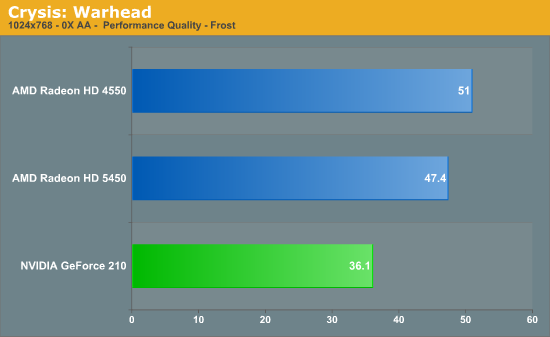
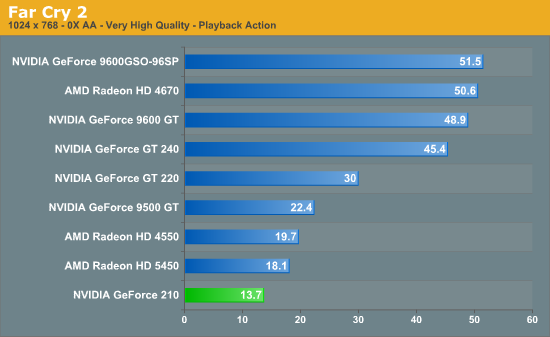
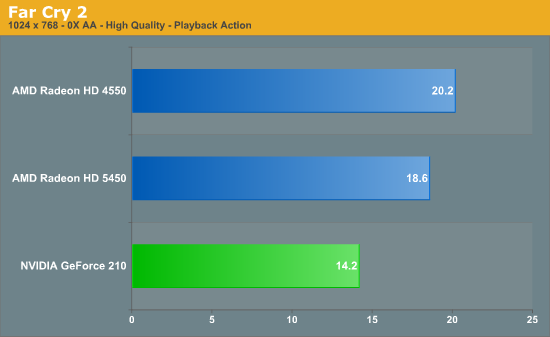
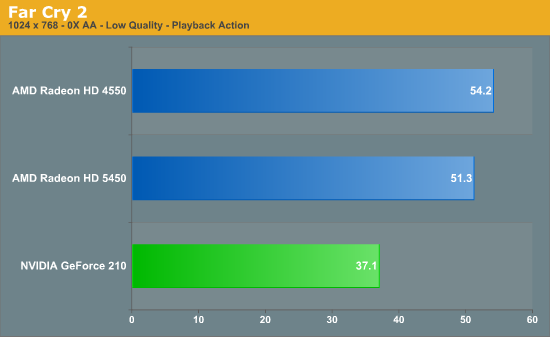

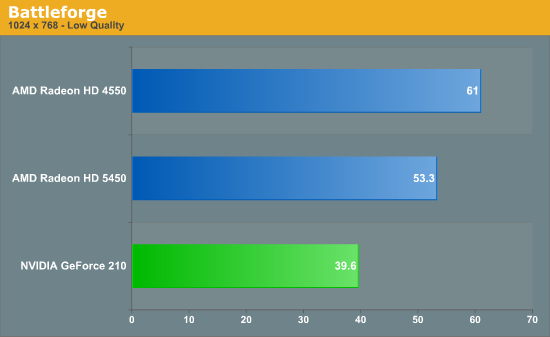
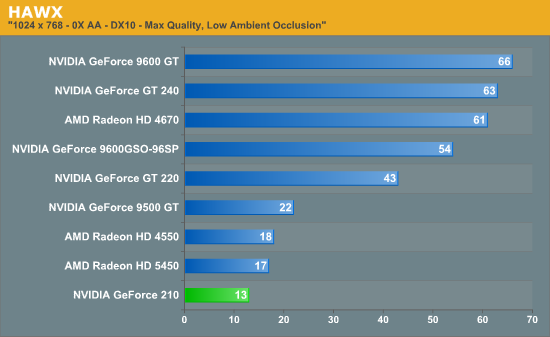
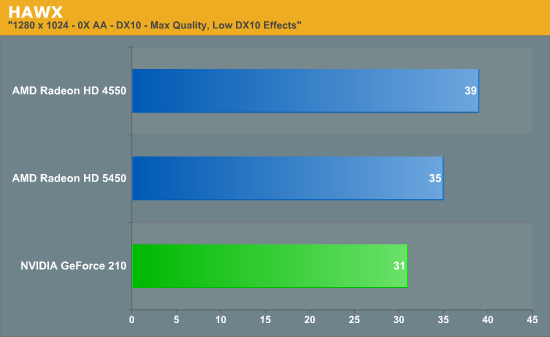

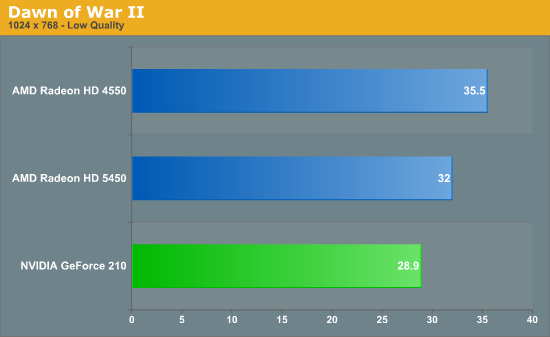

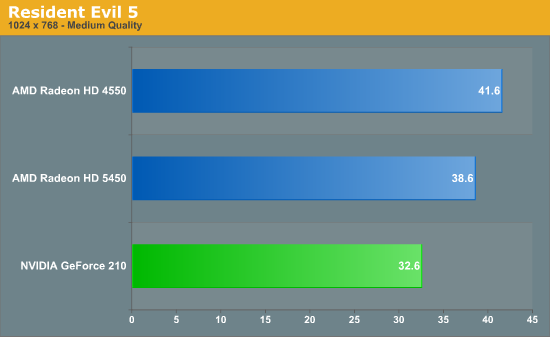
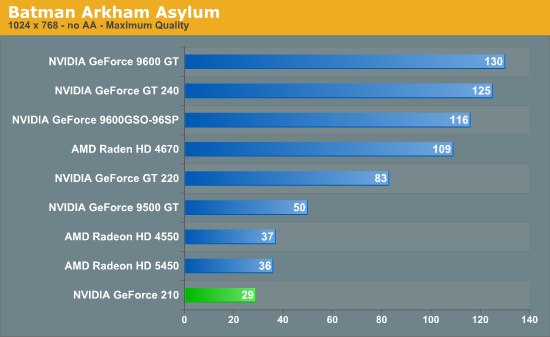

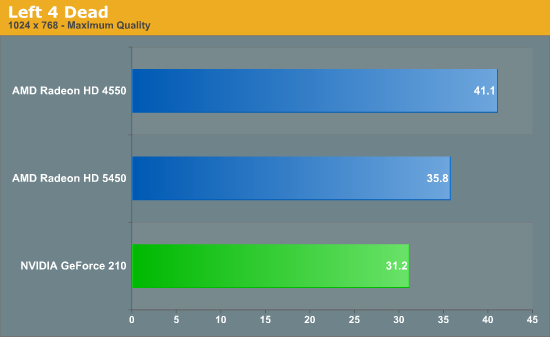
Generally speaking, the G210 is playable at 1024x768 at low settings, but little more than that. The exceptions to this are our less-complex games: Resident Evil 5, Batman, and Left 4 Dead. Resident Evil can sustain 30fps at medium quality graphics, while Batmand and L4D can sustain that framerate using high quality graphics.
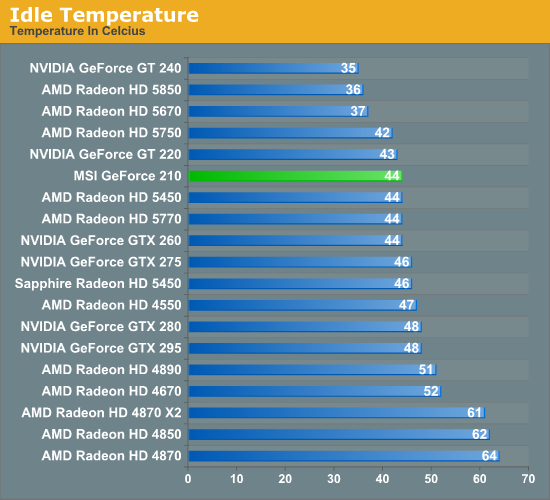
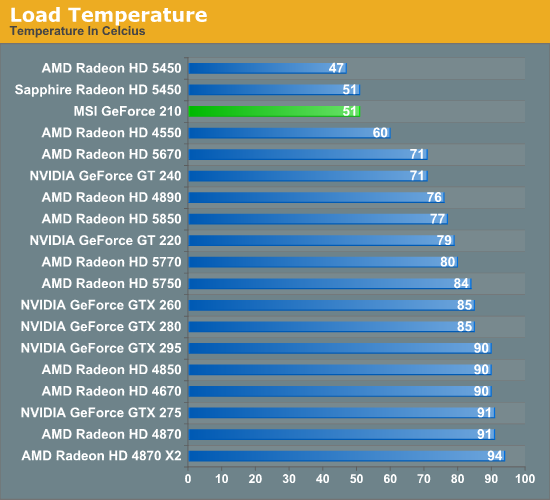
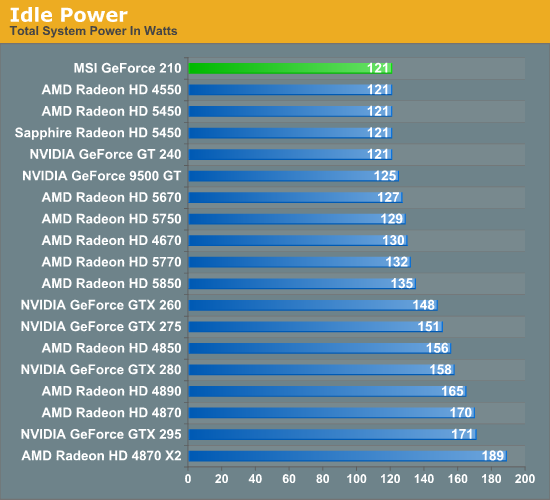
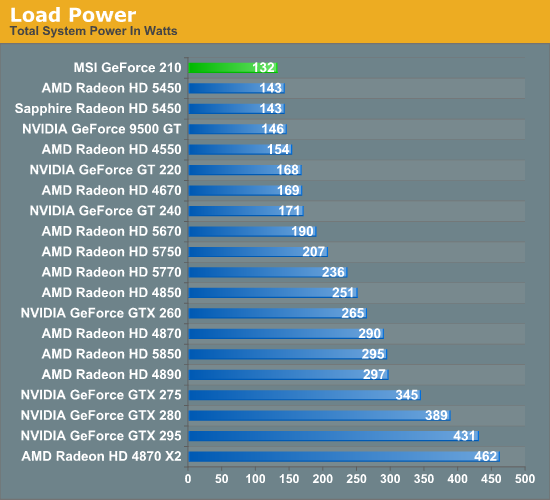
On paper the G210 should be slightly more power hungry and slightly warmer than the Radeon HD 5450 we tested last week. In practice it does better than that here, although we’ll note that some of this likely comes down to throttling NVIDIA’s drivers do when they see FurMark and OCCT. At any rate the G210 is the lowest consuming card out of all the cards we have tested, while its load temperatures are second only to the 5450. Idle power usage and temperatures are at 121W and 51C respectively, which is in-line with other passively cooled cards of this nature.










24 Comments
View All Comments
mindless1 - Thursday, February 18, 2010 - link
Can you just aim for lowest cost possible with integrated video? Of course, but as always some features come at additional cost and in this case it's motherboard features you stand to gain.The advantage is being able to use whatever motherboard you want to, instead of being limited by the feature sets of those with integrated video, boards that are typically economized low-end offerings.
JarredWalton - Tuesday, February 16, 2010 - link
If you read some of http://www.anandtech.com/mobile/showdoc.aspx?i=373...">my laptop reviews, you'll see that even a slow GPU like a G210M is around 60% faster than GeForce 9400M, which is a huge step up from GMA 4500MHD (same as X4500, except for lower clocks). HD 3200/4200 are also slower than 9400M, so really we're looking at $30 to get full HD video support (outside of 1080i deinterlacing)... plus Flash HD acceleration that works without problems in my experience. Yes, you'll be stuck at 1366x768 and low detail settings in many games, but at least you can run the games... something you can't guarantee on most IGP solutions.LtGoonRush - Wednesday, February 17, 2010 - link
We're talking about desktop cards though, and as the tests above show this card simply isn't fast enough for HTPC or gaming usage. The point I'm making is that if the IGP doesn't meet your needs, then it's extremely doubtful that a low-end card will. There's a performance cliff below the R5670/GT 240 GDDR5, and it makes more sense for the performance of IGP solutions to grow up into that space than it does to buy an incredibly cut down discrete GPU. Not that I'm expecting competitive gaming performance from an IGP of course, but R5450-level results (in terms of HTPC and overall functionality) are achievable.Ryan Smith - Wednesday, February 17, 2010 - link
Even though the G210 isn't perfect for HTPC use, it's still better than IGPs. I don't think any IGP can score 100 on the HD HQV v1 test - the G210 (and all other discrete GPUs) can.shiggz - Wednesday, February 17, 2010 - link
Recently bought a 220 for 55$ to replace an old 3470 for my HTPC. MPCHC uses dxva for decoding but shaders for picture cleanup. "sharpen complex 2" greatly improves video appearance on a 1080p x264 video but was too much for a 3470. My new 220 handles it with about 30-70% gpu usage depending on the scene according to evga precision. The 220 was the perfect sweet spot of performance/power/cost. My HTPC and 42" TV used to pour out the heat in summer leaving TV viewing unpleasant.Had a 65nm dual/8800gt thus a 200watt loaded htpc and 2x 150watt light bulbs plus 200w for the LCD tv. That was a constant 700Watts. Switch the two bulbs to new lower power 30w=150 cut the HTPC to a 45nm cpu and 40nm gpu making htpc 100w leaving me 160w+200w from tv for 360W a big improvement over 700watt. Next year I'll get an LCD backlight and I should be able to get all of that down to about 150-200w for total setup that 3 years ago was 700w.
shiggz - Thursday, February 18, 2010 - link
Meant to say "LED Backlit LCD." As their power consumption is impressive.milli - Tuesday, February 16, 2010 - link
Don't you think it's about time you stop using Furmark for power consumption testing. Both nVidia and Ati products throttle when they detect something like Furmark. The problem is that you don't know how much each product throttles so the results become inconsistent.Measuring the average power consumption during actual gaming seems more realistic to me (not just the peak). 3DMark06 Canyon Flight is a good candidate. It generates higher power usage than most games but still doesn't cause unrealistic high load on the shader domain like Furmark.
7Enigma - Wednesday, February 17, 2010 - link
I completely agree with the post above. The load power consumption chart is meaningless in this context. Feel free to keep it in if you want, but please add in a more "real-world" test, be it a demanding game or something like futuremark which, while not quite "real-world", is definitely going to get the companies to run at their peak (after all they are trying for the highest score in that instance, not trying to limit power consumption).When I read something like, "On paper the G210 should be slightly more power hungry and slightly warmer than the Radeon HD 5450 we tested last week. In practice it does better than that here, although we’ll note that some of this likely comes down to throttling NVIDIA’s drivers do when they see FurMark and OCCT", I immediately ask myself why did you choose to report this data if you know it's possibly not accurate?
What I really think a site as respected and large as Anandtech needs is proprietary benchmarks that NEVER get released to the general public nor the companies that make these parts. In a similar fashion to your new way of testing server equipment with the custom benchmark, I'd love to see you guys come up with a rigorous video test that ATI/NVIDIA can't "tailor" their products towards by recognizing a program and adjusting settings to gain every possible edge.
Please consider it Anand and company, I'm sure we would all be greatly appreciative!
iamezza - Friday, February 19, 2010 - link
+1GiantPandaMan - Tuesday, February 16, 2010 - link
So is it pretty much set that Global Foundries will be the next major builder of AMD and nVidia GPU's? Even when AMD owned GF outright they never used them for GPU's, right? What's changed other than TSMC under-delivering on 40nm for a half year?